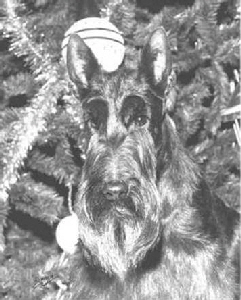



The Scottie is a small and very compact dog. He’s got a remarkably strong ribcage with a heart-like shape looking from the front. This wide and strong shape also resembles in the strong and broad hindquarters and the loin. With a height at the withers of 26 - 28 cm he weighs approx. 10 - 12 Kg. But his weight is not caused by too much food (often people will approach you talking about your “big” dog), but rather shows the powerful body that in turn does not make him lazy or slow.
During the recent 20 - 30 years changed their appearance slightly towards a more elegant type. The neck became longer, the heads narrower, the ears smaller. In the early days, the neck was described as “short”, today’s standard calls for a moderately short neck sloping into the shoulders harmonically. But yet, the neck must not be as long and elegant like in other breeds, e.g. Fox- or Lakeland Terrier.
The body is shorter and lower today. But this must not go to such an extreme that the legs can not move anymore and the Scottie can not show its powerful gait.
The remarkably strong muscles and the extraordinary large teeth did not change.
His long beard and the small eyes deeply set under the eyebrows give the Scottie his somewhat fierce look that is so typical for him.
Every part of him looks like a brick, but all lines transition smoothly into each other. The appearance of his body is further refined by good grooming.
This is important to mention: skilled grooming is inevitable to maintain the typical appearance of a Scottish Terrier
The modern Scottie is not necessarily black. Buts original brindle color was replaced by black in recent years to a large extent.
The rare sand or wheaten color has gained significant interest since the 80ies. But this color is not very easy to breed as both parents have to carry the wheaten gene.
Wheaten Scotties exist in many shades from very blond to reddish. As a downside, they tend to get lighter pigment with age. Just like with other light-colored breeds, this will sometimes be more pronounced during winter times due to the lack of sun light .
Only Scotties from the ancient English wheaten blood lines have a slightly darker shade (you should rather call them very light brindle) and often have, in addition to a black pigment, darker markings on the head (around ears and eyes).
Quite often people talk about a typical Scotties as being reserved and somewhat distant. This kind of behavior may be the reason for calling him the gentleman among the terriers. They also say that he is strict or stubborn and thus difficult to train.
The reality is that a Scottie, due to its origin (see history), had to be self-confident and able to make his own decisions - similar to Dachshunds which were originally bred for a similar purpose.

But if you get to know today’s Scotties, you will enjoy the other aspects of their character, too:
- he can be very playful and puts a lot of energy in his games (simple toys are easy victims of his big teeth)
- he is easy to train - there are a lot of Scotties which excel in sports like obedience or agility
- he is a very nice family member and considers children as his comrades
- he likes to walk - even following a (slow) bicycle ride over a moderate distance (5 - 10 km) is not a problem for him
- and he still likes to hunt - hare in the fields, mice in the ground or even lure coursing.
Bottom line, a Scottie is a dog with lots of facets that can lie quietly in a corner at home or in a restaurant, but who, on the other hand, is always ready for a play, fun or nonsense!
Today, the main countries in the world with respect to the breeding of Scottish Terriers are
- the USA ( 3.545 registered puppies in 2006), and obviously
- its home country Great Britain (2011: 695 registrations, down from 1.168 registrations in 2004).
In comparison, only 152 Scotties Scotties were bred in Germany in 2012.
(2011: 167; 2010: 172; 2009: 194; 2008: 232; 2007: 290; 2006: 233; 2005: 310).
These 162 puppies were delivered in 47 litters by 34 breeders. This means that the average litter size is around 3-4 puppies.
On the other hand, most of the active German breeders only have 1 - 2 litters per year. These numbers clearly show, that breeding Scotties is by no means anywhere close to mass production. The German breeders are a small group of engaged fanciers who put the quality of their dogs above everything.
In German breeding, the following color distribution shows up:
|

